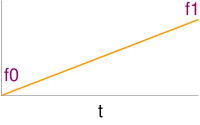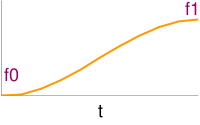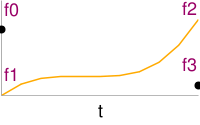Difference between revisions of "Interpolation"
(Added new section. New function 'rCosAim', does an rCos animation loop, includes speeds setting) |
|||
| Line 514: | Line 514: | ||
|- | |- | ||
|style="background-color: #eed0d0" colspan="2"| function rotation rLin(rotation r0,rotation r1,float t) | |style="background-color: #eed0d0" colspan="2"| function rotation rLin(rotation r0,rotation r1,float t) | ||
|} | |||
| Graph goes here, k. | |||
|} | |||
<div style="float:right;font-size: 80%;"> | |||
By Nexii Malthus</div> | |||
|} | |||
=== Speed Controlled === | |||
<!--############# ROTATION COSINE AIM #############--> | |||
{|cellspacing="0" cellpadding="3" border="1" style="border: 1px solid #aaaaaa; margin: 1em 1em 1em 0pt; background-color: #ffffff; border-collapse: collapse" width="80%" | |||
!style="color: #000000; background-color: #aaaaff;" height="20px"| | |||
Rotation Cosine Aim | |||
|- | |||
| | |||
Spherical Cosine interpolation of r0 and r1 with speed regulation. | |||
Does the entire animation loop to rotate between r0 to r1 with a specific speed, with the cosine interpolation it makes it appear to accelerate and deccelerate realistically. | |||
<lsl> | |||
rCosAim( rotation r0, rotation r1, float speed ){ | |||
float ang = llAngleBetween(r0, r1) * RAD_TO_DEG; | |||
if( ang > PI) ang -= TWO_PI; | |||
float x; float y = (ang/speed)/0.2; | |||
for( x = 0.0; x < y; x += 1.0 ) | |||
llSetRot( rCos( r0, r1, x/y ) ); | |||
} | |||
</lsl> | |||
{|cellspacing="0" cellpadding="3" border="1" style="border: 1px solid #aaaaaa; margin: 1em 1em 1em 0pt; background-color: #ffffff; border-collapse: collapse" width="80%" | |||
| | |||
{|cellspacing="0" cellpadding="6" border="1" style="border: 1px solid #aaaaaa; margin: 1em 1em 1em 0pt; background-color: #e0e0ff; border-collapse: collapse" | |||
!style="background-color: #d0d0ee" | Input | |||
!style="background-color: #d0d0ee" | Description | |||
|- | |||
| rotation r0 | |||
| Start, 0.0 | |||
|- | |||
| rotation r1 | |||
| End, 1.0 | |||
|- | |||
| float speed | |||
| Speed of animation | |||
|- | |||
!style="background-color: #d0d0ee" | Output | |||
!style="background-color: #d0d0ee" | Description | |||
|- | |||
| return rotation rCos | |||
| Creates a spherical cosine animation of two rotations with a specific speed | |||
|- | |||
!style="background-color: #eed0d0" colspan="2"| Requirement | |||
|- | |||
|style="background-color: #eed0d0" colspan="2"| function rotation rCos(rotation r0,rotation r1,float t) | |||
|} | |} | ||
| Graph goes here, k. | | Graph goes here, k. | ||
Revision as of 17:41, 28 November 2008
| LSL Portal | Functions | Events | Types | Operators | Constants | Flow Control | Script Library | Categorized Library | Tutorials |
Interpolation Library
Float Functions
|
Float Linear | ||||||||||||||
|---|---|---|---|---|---|---|---|---|---|---|---|---|---|---|
|
Linear interpolation of f0 and f1 with fraction t. <lsl> float fLin(float f0, float f1,float t){ return f0*(1-t) + f1*t;} </lsl>
By Nexii Malthus
|
|
Float Cosine | ||||||||||||||
|---|---|---|---|---|---|---|---|---|---|---|---|---|---|---|
|
Cosine interpolation of f0 and f1 with fraction t. <lsl> float fCos(float v0,float v1,float t){ float F = (1 - llCos(t*PI))/2; return v0*(1-F)+v1*F;} </lsl>
By Nexii Malthus
|
|
Float Cubic | ||||||||||||||||||
|---|---|---|---|---|---|---|---|---|---|---|---|---|---|---|---|---|---|---|
|
Cubic interpolation of f0, f1, f2 and f3 with fraction t. <lsl> float fCub(float f0,float f1,float f2,float f3,float t){ float P = (f3-f2)-(f0-f1);float Q = (f0-f1)-P;float R = f2-f0;float S = f1; return P*llPow(t,3) + Q*llPow(t,2) + R*t + S;} </lsl>
By Nexii Malthus
|
|
Float Hermite | ||||||||||||||||||||||
|---|---|---|---|---|---|---|---|---|---|---|---|---|---|---|---|---|---|---|---|---|---|---|
|
Hermite interpolation of f0, f1, f2 and f3 with fraction t, tension and bias. <lsl> float fHem(float f0,float f1,float f2,float f3,float t,float tens,float bias){ float t2 = t*t;float t3 = t2*t;
float a0 = (f1-f0)*(1+bias)*(1-tens)/2;
a0 += (f2-f1)*(1-bias)*(1-tens)/2;
float a1 = (f2-f1)*(1+bias)*(1-tens)/2;
a1 += (f3-f2)*(1-bias)*(1-tens)/2;
float b0 = 2*t3 - 3*t2 + 1;
float b1 = t3 - 2*t2 + t;
float b2 = t3 - t2;
float b3 = -2*t3 + 3*t2;
return ( b0 * f1+b1 * a0+b2 * a1+b3 * f2 );}
</lsl>
By Nexii Malthus
|
Vector Functions
|
Vector Linear | ||||||||||||||
|---|---|---|---|---|---|---|---|---|---|---|---|---|---|---|
|
Linear interpolation of v0 and v1 with fraction t. <lsl> vector vLin(vector v0, vector v1,float t){ return v0*(1-t) + v1*t;} </lsl>
By Nexii Malthus
|
|
Vector Cosine | ||||||||||||||
|---|---|---|---|---|---|---|---|---|---|---|---|---|---|---|
|
Cosine interpolation of v0 and v1 with fraction t. <lsl> vector vCos(vector v0,vector v1,float t){ float F = (1 - llCos(t*PI))/2; return v0*(1-F)+v1*F;} </lsl>
By Nexii Malthus
|
|
Vector Cubic | ||||||||||||||||||
|---|---|---|---|---|---|---|---|---|---|---|---|---|---|---|---|---|---|---|
|
Cubic interpolation of v0, v1, v2 and v3 with fraction t. <lsl> vector vCub(vector v0,vector v1,vector v2,vector v3,float t){ vector P = (v3-v2)-(v0-v1);vector Q = (v0-v1)-P;vector R = v2-v0;vector S = v1; return P*llPow(t,3) + Q*llPow(t,2) + R*t + S;} </lsl>
By Nexii Malthus
|
|
Vector Hermite | ||||||||||||||||||||||
|---|---|---|---|---|---|---|---|---|---|---|---|---|---|---|---|---|---|---|---|---|---|---|
|
Hermite interpolation of v0, v1, v2 and v3 with fraction t, tension and bias. <lsl> vector vHem(vector v0,vector v1,vector v2,vector v3,float t,float tens,float bias){ float t2 = t*t;float t3 = t2*t;
vector a0 = (v1-v0)*(1+bias)*(1-tens)/2;
a0 += (v2-v1)*(1-bias)*(1-tens)/2;
vector a1 = (v2-v1)*(1+bias)*(1-tens)/2;
a1 += (v3-v2)*(1-bias)*(1-tens)/2;
float b0 = 2*t3 - 3*t2 + 1;
float b1 = t3 - 2*t2 + t;
float b2 = t3 - t2;
float b3 = -2*t3 + 3*t2;
return ( b0 * v1+b1 * a0+b2 * a1+b3 * v2 );}
</lsl>
By Nexii Malthus
|
Rotation Functions
|
Rotation Linear | ||||||||||||||
|---|---|---|---|---|---|---|---|---|---|---|---|---|---|---|
|
Spherical Linear interpolation of r0 and r1 with fraction t. Also known as SLERP <lsl> rotation rLin(rotation r0,rotation r1,float t){ // Spherical-Linear Interpolation float ang = llAngleBetween(r0, r1); if( ang > PI) ang -= TWO_PI; return r0 * llAxisAngle2Rot( llRot2Axis(r1/r0)*r0, ang*t);} </lsl>
By Nexii Malthus
|
|
Rotation Cosine | ||||||||||||||
|---|---|---|---|---|---|---|---|---|---|---|---|---|---|---|
|
Spherical Cosine interpolation of r0 and r1 with fraction t. I liken to call it as SCORP <lsl> rotation rCos(rotation r0,rotation r1,float t){ // Spherical-Cosine Interpolation float f = (1 - llCos(t*PI))/2; float ang = llAngleBetween(r0, r1); if( ang > PI) ang -= TWO_PI; return r0 * llAxisAngle2Rot( llRot2Axis(r1/r0)*r0, ang*f);} </lsl>
By Nexii Malthus
|
|
Rotation Cubic | ||||||||||||||||||||||
|---|---|---|---|---|---|---|---|---|---|---|---|---|---|---|---|---|---|---|---|---|---|---|
|
Spherical Cubic interpolation of r0 and r1 with fraction t. I liken to call it as SCURP <lsl> rotation rCub(rotation r0,rotation r1,rotation r2,rotation r3,float t){ // Spherical-Cubic Interpolation // r0 = Start, r1 = End, r2 and r3 affect path of curve! return rLin( rLin(r0,r1,t), rLin(r2,r3,t), 2*t*(1-t) );} </lsl>
By Nexii Malthus
| ||||||||||||||||||||||
Speed Controlled
|
Rotation Cosine Aim | ||||||||||||||||||
|---|---|---|---|---|---|---|---|---|---|---|---|---|---|---|---|---|---|---|
|
Spherical Cosine interpolation of r0 and r1 with speed regulation. Does the entire animation loop to rotate between r0 to r1 with a specific speed, with the cosine interpolation it makes it appear to accelerate and deccelerate realistically. <lsl> rCosAim( rotation r0, rotation r1, float speed ){ float ang = llAngleBetween(r0, r1) * RAD_TO_DEG;
if( ang > PI) ang -= TWO_PI;
float x; float y = (ang/speed)/0.2;
for( x = 0.0; x < y; x += 1.0 )
llSetRot( rCos( r0, r1, x/y ) );
} </lsl>
By Nexii Malthus
| ||||||||||||||||||
Old non-documented Library
Changes/ 1.0-1.1 - Added rotation types 1.1-1.2 - Added Hermite for float and vector
<lsl> //===================================================// // Interpolation Library 1.2 // // "May 12 2008", "6:16:20 GMT-0" // // Copyright (C) 2008, Nexii Malthus (cc-by) // // http://creativecommons.org/licenses/by/3.0/ // //===================================================//
float fLin(float v0, float v1,float t){
return v0*(1-t) + v1*t;}
float fCos(float v0,float v1,float t){
float F = (1 - llCos(t*PI))/2; return v0*(1-F)+v1*F;}
float fCub(float v0,float v1,float v2,float v3,float t){
float P = (v3-v2)-(v0-v1);float Q = (v0-v1)-P;float R = v2-v0;float S = v1; return P*llPow(t,3) + Q*llPow(t,2) + R*t + S;}
float fHem(float v0,float v1,float v2,float v3,float t,float tens,float bias){
float t2 = t*t;float t3 = t2*t;
float a0 = (v1-v0)*(1+bias)*(1-tens)/2;
a0 += (v2-v1)*(1-bias)*(1-tens)/2;
float a1 = (v2-v1)*(1+bias)*(1-tens)/2;
a1 += (v3-v2)*(1-bias)*(1-tens)/2;
float b0 = 2*t3 - 3*t2 + 1;
float b1 = t3 - 2*t2 + t;
float b2 = t3 - t2;
float b3 = -2*t3 + 3*t2;
return ( b0 * v1+b1 * a0+b2 * a1+b3 * v2 );}
vector vLin(vector v0, vector v1,float t){
return v0*(1-t) + v1*t;}
vector vCos(vector v0,vector v1,float t){
float F = (1 - llCos(t*PI))/2; return v0*(1-F)+v1*F;}
vector vCub(vector v0,vector v1,vector v2,vector v3,float t){
vector P = (v3-v2)-(v0-v1);vector Q = (v0-v1)-P;vector R = v2-v0;vector S = v1; return P*llPow(t,3) + Q*llPow(t,2) + R*t + S;}
vector vHem(vector v0,vector v1,vector v2,vector v3,float t,float tens,float bias){
float t2 = t*t;float t3 = t2*t;
vector a0 = (v1-v0)*(1+bias)*(1-tens)/2;
a0 += (v2-v1)*(1-bias)*(1-tens)/2;
vector a1 = (v2-v1)*(1+bias)*(1-tens)/2;
a1 += (v3-v2)*(1-bias)*(1-tens)/2;
float b0 = 2*t3 - 3*t2 + 1;
float b1 = t3 - 2*t2 + t;
float b2 = t3 - t2;
float b3 = -2*t3 + 3*t2;
return ( b0 * v1+b1 * a0+b2 * a1+b3 * v2 );}
rotation rLin(rotation r0,rotation r1,float t){
// Spherical-Linear Interpolation float ang = llAngleBetween(r0, r1); if( ang > PI) ang -= TWO_PI; return r0 * llAxisAngle2Rot( llRot2Axis(r1/r0)*r0, ang*t);}
rotation rCos(rotation r0,rotation r1,float t){
// Spherical-Cosine Interpolation float f = (1 - llCos(t*PI))/2; float ang = llAngleBetween(r0, r1); if( ang > PI) ang -= TWO_PI; return r0 * llAxisAngle2Rot( llRot2Axis(r1/r0)*r0, ang*f);}
rotation rCub(rotation r0,rotation r1,rotation r2,rotation r3,float t){
// Spherical-Cubic Interpolation // r0 = Start, r1 = End, r2 and r3 affect path of curve! return rLin( rLin(r0,r1,t), rLin(r2,r3,t), 2*t*(1-t) );}
default{state_entry(){}}
</lsl>


